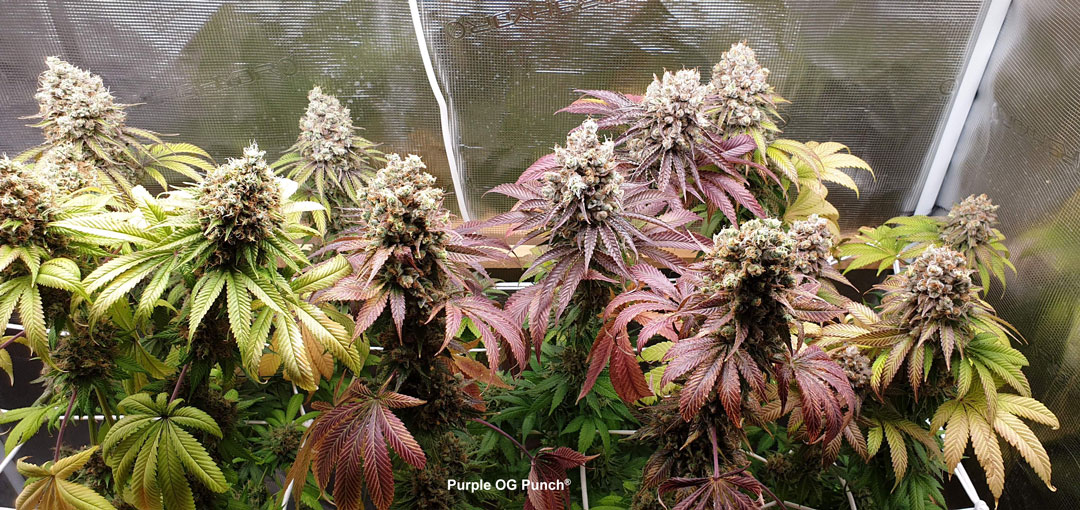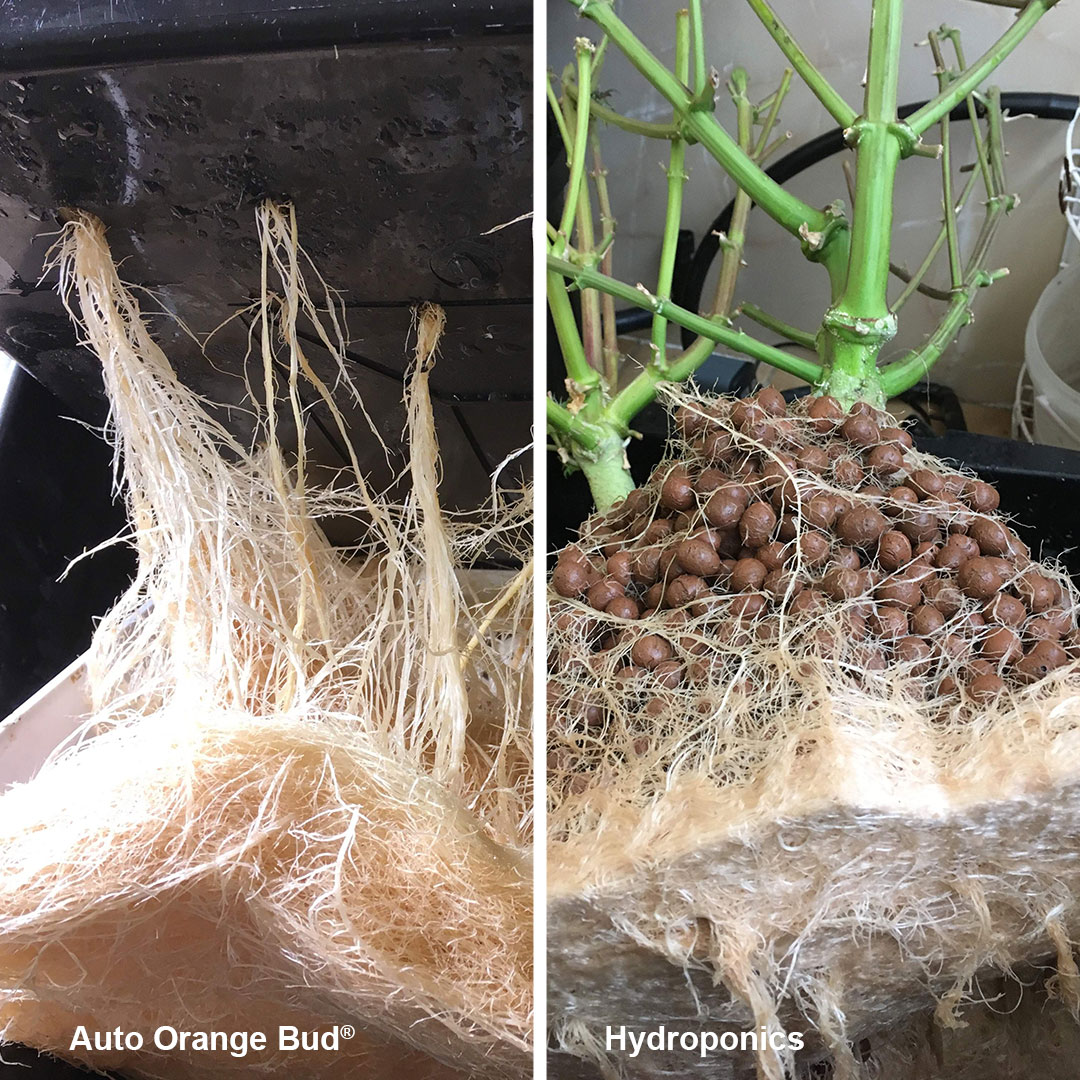Organic vs mineral nutrients for cannabis

Mineral nutrients are those that are typically bought as clear, transparent bottled liquids. They work well and many growers use nothing else. Usually, they are prepared in high-tech facilities where quality and consistency are tightly controlled.
Organic nutrients are often prepared from sustainable plant/animal sources. They break down in the soil gradually releasing an enriching blend of beneficial additives thanks to microbial/fungi activity. Both mineral and organic nutrients have their own benefits, but surprisingly few growers appreciate the full benefits and ease of grow possible with the best slow-release organic nutrients.
The basics of fertilisers / nutrients for cannabis

As a cannabis seed germinates and grows it absorbs minerals and nutrients from the grow medium. These nutrients may be naturally present (e.g. in soil) or they may have to be artificially added (e.g. cannabis hydroponics). A fertiliser is anything that provides useful additional mineral/nutrients to your plants. These may be solid or liquid nutrients.
A cannabis grower using a large container of soil containing slow-release organic nutrients (BioTabs produce excellent results and are highly recommended) may never need to add anything but water to their grow. This makes for a simple, easy grow with little opportunity for the rookie grower to compromise their plants through the well-worn path of over/under feeding.
A hydroponics cannabis grower, conversely, is fully responsible for all the nutritional needs of the developing plant. For the experienced hydroponic-professional this isn’t an issue, and they can benefit from faster growth compared to soil. But the accuracy/experience required to keep the plant in the hydroponic nutrient sweet spot from cannabis seed to harvest (without over/under feeding) is demanding and tends to suit the more experienced grower.
Did you know? Greenhouse farmers led the way and inspired cannabis growers. The Netherlands were always at the forefront of greenhouse farming. Dutch farmers use mineral feeding in order to be able to steer their crop with instant effects, getting the highest yield. Many growers also prefer to work as cleanly as possible and mineral feeding gives them this opportunity.
The drawbacks of mineral nutrients in modern farming
To create mineral nutrients, you have to continually mine/extract the necessary chemicals and mix them in carefully controlled factory conditions. The mineral nutrients may be rich in nitrates, phosphates and other plant useful nutrients. Many view mineral nutrients as less sustainable and less eco-friendly compared to natural organic nutrients.
But from the grower’s perspective, one of the main challenges with mineral nutrients is correct dosage. Prepare/mix your mineral nutrients in an excessively strong concentration and you will see nutrient burn on your plants (scorched leaves and possibly permanent growth stunting). Delivering nutrients that are too dilute will also restrict your plant growth. Many less experienced growers find mineral nutrients a little too user-unfriendly.
Organic vs mineral nutrient differences for cannabis plants
As a cannabis grower your main nutrient choice is between organic or mineral nutrients. Organic nutrients are available in slow-release form (e.g. BioTabs) or bottled form. Mineral nutrients are often clear solutions without any solids.
Mineral nutrient bottles usually don’t need shaking to re-distribute any ‘precipitation’ that may have accumulated at the bottom. For that reason (potential pipe blockages) hydroponic growers tend to use mineral nutrients which are cleaner to work with and shouldn’t create any pipe blockages.
But both organic and mineral nutrients do the same job - provide nutrition to the cannabis plant whether it’s in vegetative growth or the cannabis bloom phase.
Cost

With so many suppliers offering mineral nutrients competition is high and prices are reasonably competitive. Organic nutrients are often priced a little higher, with fewer supplier options. But in relation to the overall value of the harvest, the small premiums paid for organic nutrients are rarely regarded as unfairly high.
| Organic nutrients | Mineral nutrients | |
| Pros | Slow-release organics remove much of the complexity. | Wide choice, competitively priced. |
| Cons | Often slightly more expensive. | Incorrect dosing (over/under feeding) is a common quality-limiting factor, especially for less experienced growers. |
Ease of use

Especially for the less confident or less experienced cannabis grower, ease of use is the real advantage of organic nutrients. Slow-release organics offer by far the easiest grow experience, gradually producing a steady stream of nutrients and beneficial microbes/fungi at root level. Slow-release organic nutrients will often mean that the grower needs only add water for much of the grow.
| Organic nutrients | Mineral nutrients | |
| Pros | Often regarded as easier to use, slow-release organic nutrients offer the ultimate in grow convenience. | Mineral nutrients allow precision nutritional control and are very effective, especially in expert hands. |
| Cons | Over/under feeding can still be seen when using bottled organic nutrients because part of their mineral content may be immediately/quickly available. But slow-release organics offer the easiest nutrient management option. | For less experienced growers it can be tricky avoiding the perils of over/under feeding with mineral nutrients. |
Sustainability

One of the other main benefits of organic nutrients compared to mineral nutrients is their sustainability. Mineral nutrients require large quantities of chemicals to be produced/mined, transported and mixed.
| Organic nutrients | Mineral nutrients | |
| Pros | Prepared from plant & animal sources, organic nutrients don’t require mining of minerals/chemicals. | |
| Cons | Some growers don’t approve of animal-based nutrient ingredients e.g. Blood, bone & fish products. But vegan organic nutrients are available. | Requiring a constant supply of new chemicals to be mined, mineral nutrients can’t be regarded as sustainable. |
Soil health

Soil health will be good when either organic or mineral nutrients are used. But soil health is maximised with organic nutrients since they often contain beneficial microbes and fungi which improve soil health, constantly breaking down organic material to liberate more minerals and nutrients.
Soil health is so good with organic nutrients that many organic growers will re-use their soil several times, often claiming that the results improve. Few of those that grow with mineral nutrients will re-use their soil in the same way with the same results. Organic nutrients are often preferred by connoisseur growers, some of whom find the ultimate organic approach is to use a living soil with organic nutrients.
| Organic nutrients | Mineral nutrients | |
| Pros | Organic nutrients boost soil health, allowing a thriving root eco-system. Many organic growers re-use soil with excellent results, creating cash savings. | |
| Cons | Mineral nutrients do little to improve soil health, they simply deliver the necessary nutrients at that particular stage of plant growth. |
Nutrient absorption speed

You can grow great, healthy cannabis plants with either organic or mineral nutrients. Mineral nutrients deliver the pure chemicals in a quickly absorbed form to the roots. That means plants can quickly benefit from the nutrients. The downside to this is that you can ruin an entire hydroponic crop with alarming speed if the mineral nutrients are incorrectly prepared.
But organic nutrients also deliver the cannabis plant the necessary nutrition, even if some of it is created through slow, ongoing microbia/fungil breakdown of organic matter within the soil. When used well, expect XL harvest and high THC levels from either organic nutrients or mineral nutrients.
| Organic nutrients | Mineral nutrients | |
| Pros | Some bottled organic nutrients supplied in liquid form allow fast mineral absorption e.g. if a nutrient deficit is seen. But slow-release organics produce a steady stream of nutrients as they gradually break down. | Mineral nutrients supply the minerals in an aqueous form, instantly available for root absorption. This allows the skilled grower to offer exacting nutritional delivery. |
| Cons | If the hydroponic grower accidentally creates nutrients that are too concentrated the entire crop exposed to them may be irreversibly damaged. |
Plant health and yield

You can expect healthy, heavy-yielding plants whether using organic or mineral nutrients. Deliver the right nutrients when your plant needs them, and you are helping the plants reach their full genetic potential.
If you can manage the complexities of mineral nutrients, then you will achieve consistent success. However, if mineral nutrients cause you occasional issues with over/under feeding then don’t leave it too long before you discover the wonders of organic nutrients, especially slow-release organics.
For the very heaviest yields, hydroponics with mineral nutrients is the grow method with the best reputation.
| Organic nutrients | Mineral nutrients | |
| Pros | Many growers feel the added root benefits from microbial and fungi activity results in optimised plant health. | Mineral nutrients deliver excellent results. In the hands of a hydroponics grower, yields can be unsurpassed. |
| Cons | Risk of over/under feeding issues for less experienced grower. |
Aroma and taste

Good aroma and taste in your cannabis buds is a product of quality cannabis genetics combined with effective grow room management/control. Although many organic growers claim the moral high-ground when it comes to taste/aroma, hydroponic growers dispute the claims that they can’t match organic flavour. Studies done on soil grown Strawberries vs hydroponically grown Strawberries have failed to show significant taste differences.
| Organic nutrients | Mineral nutrients | |
| Pros | For many, the best aroma and taste come from organically fed cannabis. | Control mineral nutrients well and you can also expect excellent taste and aroma. |
| Cons |
Key reasons why you should root for organic cannabis

When you buy ‘street’ cannabis you can rarely feel completely confident that the weed is free from pesticides, PGR (plant growth regulators) or other potentially unhealthy contaminants. Growing your own weed from cannabis seeds is, for many, the best way to ensure pure, safe cannabis. Grow your cannabis organically yourself and, with a little bit of experience, you can grow superior quality buds to anything you could buy locally.
Organically grown cannabis doesn’t mean sacrificing effects/potency. Many organic growers find the process of growing cannabis naturally in optimised conditions actually gives the best tasting buds and maximised cannabinoid/terpene levels.
One of the main takeaways from this article is that there are superior alternatives for those that routinely struggle with the yo-yo effects of underfeeding and over feeding their cannabis plants using mineral nutrients. Organic nutrients are a great alternative, especially slow-release organic nutrients which gradually breakdown producing a steady stream of minerals, nutrients and useful microbial activity.
Bonus tips for the serious grower!
• Water dechlorination. Although the effects of chlorinated water are rarely considered by most growers, connoisseur cultivators often have their own approach. One option to remove trace levels of chlorine (introduced at water treatment facilities) is to leave the water to stand for a day or two before use. Other growers use reverse osmosis filters, or additives which convert chlorine into the less damaging chloride form.
• Steady grow room temperatures should be maintained, avoiding temperature extremes. Around 20-25 Celsius (70-77F) is typical.
• Ensure good air flow around your plants and introduce plenty of fresh air to ensure optimised plant health and photosynthesis.
• Use of LEDs and if possible supplementary UVA/UVB lights will help maximise cannabinoid and terpene levels.
• Research your feminised seed and autoflower seed options carefully. Seed quality will have a huge influence on the final quality levels you achieve.
| Related: |
| How to grow indoor cannabis |
Organic vs mineral nutrients FAQ

Both mineral and organic nutrients will deliver excellent results when used correctly. But slow-release organic nutrients deserve their reputation for greatly simplifying nutrient management. This is especially true for the less experienced grower seeking a feeding system with maximised working latitude and minimised scope for error. Slow-release organics gently release a flow of nutrients, making growing easy and (largely) eliminating the precise dosing requirements of mineral nutrients.
Can you combine organic and synthetic fertilisers?
Yes. The plants don’t care where the minerals and nutrients come from or how they are delivered. Cannabis can grow in hydroponics with a full mineral feed regime. Or they can grow in soil and rely on organic feeds.
Some of those that use the tried-and-tested BioTabs slow-release organic nutrients often use a light top dressing of general-purpose mineral bloom feed towards the end of flowering if the plants are looking a little hungry.
What is the best nutrient mix for cannabis?

Cannabis plants grow well over a wide range of conditions, in different grow mediums and with different grow systems (soil, coco, hydroponics etc). Nutrients from a wide range of manufacturers can all be used so long as the dosing is correctly administered and the cannabis plants are maintained in the nutrient sweet spot.
If you are a new grower feeling a little confused by the endless mineral nutrient options (and how to use them) then without doubt, slow-release organics are your best option. Simply mix them in the soil/grow medium at the start of the grow and you will have to do little other than add water throughout the grow. If you do need to add any additional nutrients at all it may simply be a little general purpose bloom feed in the last couple of weeks.
Can you overfeed cannabis with organic nutrients?
Yes. If you use bottled organic nutrients, you can over-feed your plants just as easily as if you were using bottled mineral nutrients. If over feeding (and under feeding) your cannabis plants has been a frequent issue for you then it could be time to try a different approach. Slow-release organic nutrients, especially those from BioTabs, have been a complete game changer for many growers allowing them to wave goodbye to under/over feeding issues.
Should you use more nutrients with every watering?
Not necessarily, it’s important to be able to ‘read’ your plant needs. As a general rule, though, plants often gradually increase their nutritional intake as growth increases and the cannabis plant develops. But give your plants nutrients that are simply too concentrated and your plant will be unable to cope, showing scorched (brown tipped) leaves.
One of the most important skills required by competent growers is mastering the nutrient management of their cannabis plants. Plants have different needs in seedling stage, vegetative growth and the cannabis bloom stage. They may require gradually more concentrated nutrients as they age. But exceed the safe level and the plants will suffer - so will the quality/quantity of your harvest.
For those that struggle with nutrient control, slow-release organic nutrients really are the ultimate in ease-of-use and grower convenience. Many hobby growers have elevated their crops to professional-level simply by swapping troublesome mineral nutrients for slow-release organic nutrients. Note that, for some growers, this change is transformational.
Do you need to flush organic nutrients for cannabis?
The value of flushing cannabis is not scientifically proven and still the subject of some debate within the cannabis community. Many growers feel that they get a ‘cleaner’ smoke when the cannabis plant has been fed only pure water for the last week or two. The logic is that this allows the plant to ‘flush’ out any unwanted minerals. Those opposed to flushing claim it deprives the plant of essential nutrients at a key stage of life.
A couple of scientific studies have measured mineral levels in cannabis buds that have been flushed vs those without flushing. No difference (!) was seen in the mineral levels between un-flushed buds and those that were flushed for 7, 10 or 14 days. Those that want to read more about the debate on cannabis flushing may want to check out the following article which has links to the scientific studies that cast doubt on the justification for cannabis flushing.




























